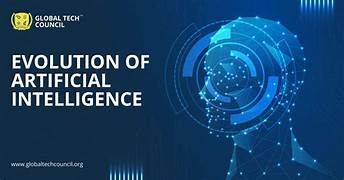The Evolution of Artificial Intelligence
Introduction
Artificial Intelligence (AI) has evolved from a theoretical concept into a transformative force that shapes various aspects of modern society. From early attempts to simulate human intelligence to the development of advanced machine learning models, AI has undergone significant changes over the decades. This article explores the history, key milestones, and future prospects of AI, highlighting how it has evolved into a revolutionary technology.
The Birth of AI: Early Concepts and Foundations
The concept of artificial intelligence dates back to ancient civilizations, where myths and stories often depicted machines with human-like intelligence. However, AI as a scientific field began to take shape in the mid-20th century.
- Theoretical Foundations:
- The idea of mechanized reasoning can be traced to philosophers like Aristotle, who explored logic-based thinking.
- In the 17th and 18th centuries, mathematicians such as Gottfried Leibniz and Blaise Pascal developed mechanical calculators capable of performing arithmetic operations.
- The Turing Test (1950):
- British mathematician and logician Alan Turing proposed the Turing Test, which evaluates a machine’s ability to exhibit intelligent behavior indistinguishable from a human.
- His paper, Computing Machinery and Intelligence, laid the groundwork for AI research.
The Birth of AI Research (1950s – 1970s)
The official birth of artificial intelligence as an academic discipline occurred in the 1950s. This period marked the beginning of significant research into machine intelligence.
- The Dartmouth Conference (1956):
- Organized by John McCarthy, Marvin Minsky, Nathaniel Rochester, and Claude Shannon, this event introduced the term Artificial Intelligence.
- Researchers believed that human-like intelligence could be replicated in machines.
- Early AI Programs:
- Logic Theorist (1955–1956) by Allen Newell and Herbert A. Simon was one of the first AI programs capable of solving mathematical theorems.
- General Problem Solver (1957) attempted to solve a wide range of problems using symbolic logic.
- Limitations and AI Winter:
- Early AI systems struggled with real-world complexity and required excessive computing power.
- By the 1970s, funding for AI research declined due to unmet expectations, leading to the first AI Winter.
The Rise of Machine Learning (1980s – 1990s)
Despite setbacks, AI research regained momentum in the 1980s, thanks to the emergence of machine learning and expert systems.
- Expert Systems:
- These AI programs mimicked human decision-making in specialized fields like medicine and finance.
- Systems like MYCIN (used for diagnosing bacterial infections) and XCON (used in computer manufacturing) showcased AI’s potential.
- Introduction of Neural Networks:
- Geoffrey Hinton and other researchers revived interest in artificial neural networks, inspired by the workings of the human brain.
- The development of backpropagation algorithms allowed neural networks to learn from data more efficiently.
- Advancements in Robotics:
- AI-driven robots were used in manufacturing, space exploration, and military applications.
- Japan pioneered the use of AI in industrial robots, enhancing production efficiency.
The Big Data Revolution and Deep Learning (2000s – 2010s)
The 21st century saw an explosion in AI capabilities, fueled by vast amounts of data, powerful computing resources, and advanced algorithms.
- Big Data and AI:
- The internet, social media, and digital services generated massive datasets.
- AI models could now process and analyze large-scale data to identify patterns and make predictions.
- The Rise of Deep Learning:
- Deep learning, a subset of machine learning, utilizes multi-layered neural networks.
- Breakthroughs included:
- AlexNet (2012): A deep learning model that revolutionized image recognition.
- Google DeepMind’s AlphaGo (2016): Defeated a world champion in the complex board game Go.
- AI in Everyday Life:
- Voice assistants like Siri, Alexa, and Google Assistant became mainstream.
- AI-powered recommendation systems enhanced platforms like Netflix, YouTube, and Amazon.
- Self-driving cars and smart cities became promising applications.
The Age of General AI and Ethical Considerations (2020s – Future)
As AI continues to advance, discussions about Artificial General Intelligence (AGI) and ethics are becoming more prominent.
- General AI vs. Narrow AI:
- Narrow AI (current AI systems) specializes in specific tasks like language processing and image recognition.
- General AI (AGI) aims to replicate human-like intelligence across multiple domains.
- AI Ethics and Bias:
- Concerns about data privacy, bias in AI algorithms, and ethical implications have led to stricter regulations (e.g., GDPR, AI Act).
- Companies and researchers are exploring explainable AI (XAI) to make AI decision-making more transparent.
- Future Prospects:
- AI-powered healthcare solutions could predict diseases and assist in drug discovery.
- Advanced quantum computing might exponentially enhance AI capabilities.
- AI could augment human intelligence through brain-computer interfaces (BCIs).
Conclusion
The evolution of AI has been marked by groundbreaking discoveries, setbacks, and rapid advancements. From early symbolic reasoning to deep learning and AGI research, AI continues to shape the future of technology and society. As we move forward, balancing innovation with ethical considerations will be crucial in ensuring AI benefits humanity in a responsible manner.


